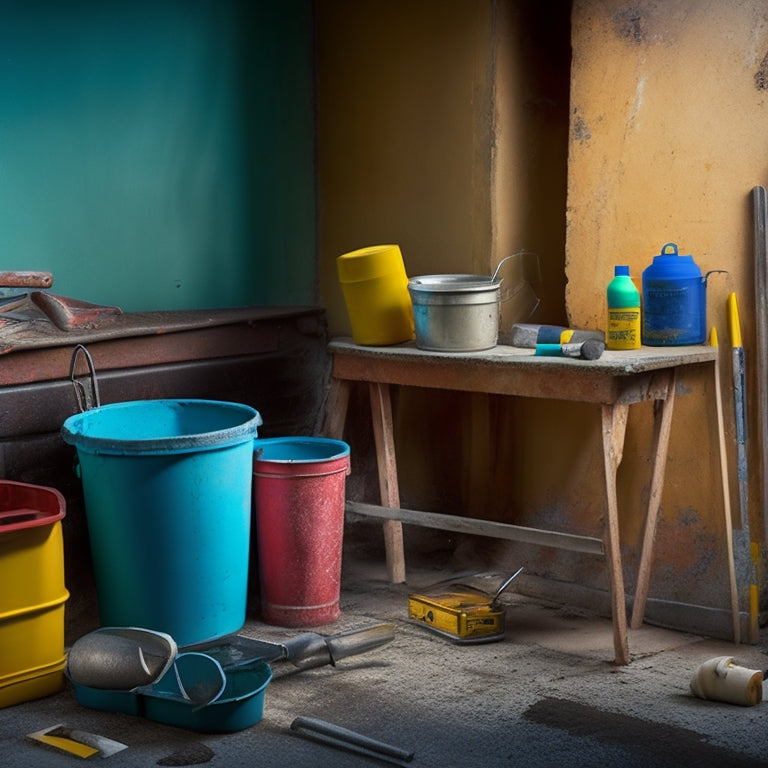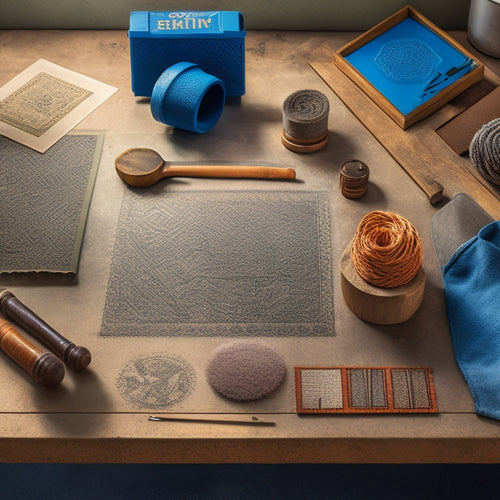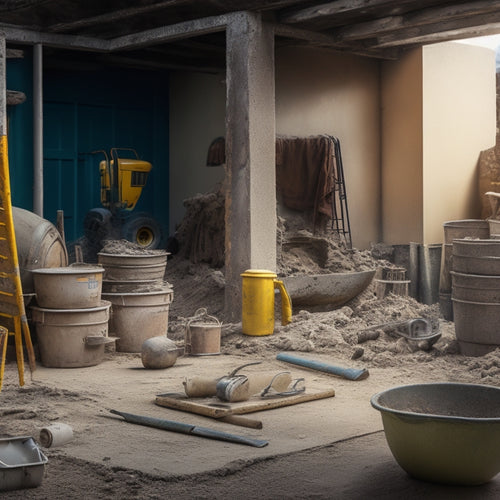
Top Tools for Fixing Cracked Concrete Walls
Share
When fixing cracked concrete walls, you'll need a robust drill with high torque and variable speed settings, along with tungsten carbide or diamond-coated drill bits. For patching compound application, use a mixing stick or paddle, putty knife, and notched trowel. Don't forget a variety of trowels, including pointing, margin, finishing, and V-notch options. Additionally, choose the right sealant for the job, and clean and prepare the surface with wire brushes and pressure washing. With these essential tools and equipment, you'll be well on your way to a successful repair, but to guarantee a professional finish, you'll want to learn more about the techniques and best practices involved.
Key Takeaways
• Essential drilling equipment includes a robust drill, tungsten carbide or diamond-coated drill bits, and safety gear for protection.
• Patching compound application tools, such as mixing tools, putty knives, and trowels, are necessary for smoothing and finishing.
• A variety of trowels, including pointing, margin, finishing, notched, and V-notch trowels, are used for different tasks and crack sizes.
• Sealant choice depends on crack width, depth, and exposure, and following manufacturer instructions is critical for application and curing times.
• Safety precautions, including gloves, safety glasses, and dust masks, are essential during repair work to ensure a safer working environment.
Essential Drilling Equipment Needed
You'll need to equip yourself with a robust drill and an assortment of drill bits specifically designed for concrete to effectively penetrate and repair cracked concrete walls. These drill bits should be made from high-quality tungsten carbide or diamond-coated materials to guarantee they can withstand the rigors of drilling into concrete.
When selecting a drill, opt for one with high torque and variable speed settings to accommodate different drilling techniques. Additionally, prioritize safety by investing in essential safety equipment such as safety glasses, gloves, and a dust mask to protect yourself from debris and dust generated during the drilling process.
It's vital to adopt proper drilling techniques to avoid damaging the surrounding concrete or causing further cracks. This includes applying gentle to moderate pressure, maintaining a consistent drilling speed, and regularly cleaning the drill bit to prevent clogging.
Patching Compound Application Tools
After successfully drilling into the cracked concrete wall, you're ready to apply a patching compound to fill the damaged area, and for this, you'll need a set of specialized tools.
To guarantee a strong and durable bond, it's crucial to choose the right application tools for your specific patching techniques and compound types.
For epoxy-based compounds, you'll need a mixing stick or paddle to thoroughly combine the resin and hardener. A putty knife or margin trowel is ideal for applying and smoothing out the compound, while a notched trowel helps to create a textured finish.
For thicker, cement-based compounds, a heavy-duty trowel or screed board is necessary to spread and level the material.
Additionally, consider investing in a grout float or finishing tool to remove excess compound and achieve a smooth finish. When working with fast-setting compounds, a speed mixer or drill-mounted mixer can save time and guarantee proper mixing.
Widest Range of Trowels Available
With a vast array of trowels at your disposal, selecting the right one for your specific patching needs becomes a essential step in guaranteeing a successful concrete wall repair. You'll want to take into account factors like the size and shape of the crack, the type of concrete, and the desired finish.
Here's a breakdown of some common trowel types and their uses:
| Trowel Type | Size Range | Best For |
|---|---|---|
| Pointing Trowel | 2-4 inches | Small cracks and joints |
| Margin Trowel | 4-6 inches | Edging and corner work |
| Finishing Trowel | 6-12 inches | Smoothing and finishing large areas |
| Notched Trowel | 6-12 inches | Applying compound to large cracks |
| V-Notch Trowel | 2-4 inches | Creating sharp, defined edges |
Proper trowel maintenance is also essential. Regularly clean and dry your trowels to prevent rust and damage. Store them in a protective case or wrap them in a cloth to maintain their edge. By choosing the right trowel for the job and keeping it in good condition, you'll achieve a professional-looking finish and guarantee a long-lasting repair.
Best Sealant Options for Cracks
Selecting the right sealant for your cracked concrete wall is critical, as it will determine the long-term durability and effectiveness of the repair. You'll want to choose a sealant that's specifically designed for concrete and can withstand the harsh conditions it'll be exposed to.
Silicone sealants are a popular choice for concrete repairs because they're flexible and can expand and contract with the concrete as it shifts. They're also resistant to weathering, UV light, and chemicals.
Polyurethane options are another great choice, as they offer excellent adhesion to concrete and provide a strong, flexible bond. They're also available in a range of colors to match your wall's original appearance.
When selecting a sealant, consider the width and depth of the crack, as well as the surrounding environment. For example, if the crack is in an area that's exposed to heavy traffic or water, you'll want to choose a sealant that's specifically designed to handle those conditions.
Always follow the manufacturer's instructions for application and curing times to guarantee a successful repair. By choosing the right sealant for your cracked concrete wall, you'll be able to restore its structural integrity and prevent further damage.
Cleaning and Preparing Surfaces
You'll need to thoroughly clean the cracked concrete wall to guarantee a strong bond between the sealant and the surface, removing any dirt, oil, or old adhesives that may interfere with the repair. This vital step in surface preparation guarantees a successful fix.
Start by sweeping or blowing away loose debris, then use a wire brush or scrubber to remove stubborn dirt and grime. For tougher contaminants, consider using a degreaser or a concrete-specific cleaner. Be sure to follow the manufacturer's instructions and take necessary safety precautions.
Next, use a pressure washer to rinse the surface, removing any remaining dirt and cleaning solution. Allow the wall to dry completely before proceeding.
Depending on the severity of the crack, you may need to use additional cleaning techniques, such as sanding or grinding, to create a rough surface for the sealant to bond to.
Proper surface preparation is key to a lasting repair, so take your time and don't skip this critical step. By following these cleaning techniques, you'll guarantee a strong bond and a successful fix for your cracked concrete wall.
Reinforcing Mesh Installation Tools
To guarantee the crack repair holds up over time, install a reinforcing mesh over the cleaned and prepared surface, using specialized tools to secure it firmly in place.
You'll need to choose the right mesh type for your project, such as a self-adhesive mesh or a polypropylene mesh. Each has its own strengths and weaknesses, so make certain to select the one best suited to your specific needs.
When it comes to installation techniques, you'll want to ascertain a snug fit. Use a mesh roller to apply even pressure and eliminate air pockets. For larger areas, consider using a mesh stretcher to keep the material taut. In corners and tight spaces, a mesh cutter will come in handy.
Don't forget to wear gloves and safety goggles to protect yourself from sharp edges and stray fibers.
Proper installation is essential to the success of your repair. By using the right tools and techniques, you'll create a strong, durable bond between the mesh and the concrete.
This will help to prevent further cracking and guarantee a long-lasting fix.
Mixing and Applying Epoxies
Mixing epoxies to the correct ratio and applying them with precision is vital for creating a strong, lasting bond between the concrete and the reinforcing mesh.
You'll need to choose the right epoxy type for your project, as different epoxies have varying properties and uses. For example, polyurethane-based epoxies are flexible and suitable for areas with high movement, while epoxy-based epoxies are more rigid and ideal for structural repairs.
When mixing epoxies, follow the manufacturer's instructions to guarantee the correct ratio of resin to hardener. It's essential to mix thoroughly, as insufficient mixing can lead to a weak bond.
Apply the epoxy using a suitable application technique, such as injection, pouring, or brushing, depending on the specific requirements of your project. Make sure the surface is clean, dry, and free of contaminants to guarantee a strong bond.
Use a mixing stick or paddle to apply the epoxy, working from the center of the repair area outwards to avoid air entrapment. By following these steps, you'll be able to create a strong, durable bond that will withstand the test of time.
Smoothing and Finishing Tools
With the epoxy fully cured, it's time to focus on smoothing and finishing the repaired area using specialized tools designed to remove excess material, feather out edges, and achieve a uniform surface texture.
You'll need a range of tools to achieve a professional-looking finish. Start with a putty knife or trowel to remove excess epoxy and smooth out the surface. For more precise control, use a scraper or a flat-edged chisel to feather out the edges.
Next, switch to a sanding block or an orbital sander equipped with progressively finer grits of sandpaper to achieve a smooth, even finish. Don't forget to wear protective gear, including gloves, safety glasses, and a dust mask.
Frequently Asked Questions
Can I Fix a Cracked Concrete Wall on My Own Without Professional Help?
You're wondering if you can tackle a cracked concrete wall on your own without calling in the pros. The answer is, it depends.
If the crack is minor and you're comfortable with DIY concrete repairs, you might be able to handle it.
But first, identify the common crack causes, such as settlement or water damage, to guarantee you're addressing the root issue.
How Long Does It Take for Concrete Patching Compounds to Fully Dry?
Did you know that the average drying time for concrete patching compounds is around 24 hours?
When you're fixing that cracked concrete wall, you're not just waiting for the compound to dry; you're waiting for it to undergo a thorough curing process. This process can take anywhere from a few hours to several days, depending on the type of compound and environmental conditions.
You'll know it's fully dry when it's hardened to the touch and no longer sticky.
Are There Any Eco-Friendly Options for Concrete Crack Sealants?
You're looking for eco-friendly options for concrete crack sealants. Luckily, you've got several choices.
Opt for sealants made from eco-friendly materials like plant-based polyurethane or recycled materials. These sustainable practices reduce your carbon footprint and minimize environmental impact.
Look for products with low VOCs (volatile organic compounds) and non-toxic ingredients. Some popular brands offer environmentally responsible sealants that meet your standards.
Research and choose the one that best fits your needs.
Can I Paint Over a Repaired Concrete Wall Without Special Prep?
Did you know that 75% of concrete walls develop cracks within the first year of construction?
When it comes to painting over a repaired concrete wall, you'll need to prepare the surface carefully. You can use either latex, epoxy, or acrylic paint, but the wall texture plays an essential role.
If the wall has a rough texture, you may need to apply a primer first.
Make certain the repaired area is fully cured and clean before painting to guarantee a strong bond and a professional finish.
Do I Need to Replace the Entire Wall if the Crack Is Very Large?
You're faced with a large crack in your concrete wall, and you're wondering if replacement is the only option.
Before making a decision, you need to evaluate the crack's impact on the wall's structural integrity. Conduct a thorough crack evaluation to determine the extent of the damage.
If the crack is superficial, repair might be sufficient.
However, if it compromises the wall's load-bearing capacity, replacement may be necessary to guarantee safety and prevent further damage.
Conclusion
As you stand back to admire your handiwork, the once-cracked concrete wall now stands strong, a symbol of your perseverance and the right tools.
Like a surgeon's scalpel, each instrument played its part in the repair, from drilling to sealing, patching to reinforcing.
The cracks are now just a distant memory, replaced by a smooth, unblemished surface that's as good as new.
Your fix has given the wall a new lease on life, and you can take pride in a job well done.
Related Posts
-

Best Tools for Concrete Restoration and Repair
When tackling concrete restoration and repair projects, you need a range of reliable tools to achieve professional-gr...
-

5 Best Tools for Stamping Concrete Walls
When it comes to stamping concrete walls, you'll need a range of specialized tools to achieve the desired texture and...
-

What Tools Are Needed for Concrete Wall Foundations
You'll need a thorough array of tools and equipment to construct a concrete wall foundation that meets structural int...


